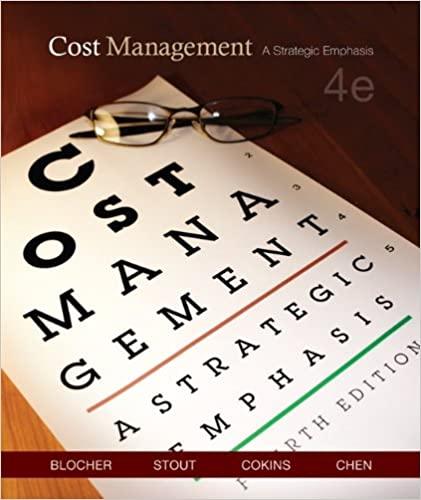Question
5. Identify the type of transaction for (a) through (k) for the statement of cash flows (O for operating, I for investing, F for financing),
5. Identify the type of transaction for (a) through (k) for the statement of cash flows (O for operating, I for investing, F for financing), and the direction and amount of the effect. (List cash outflows as negative amounts. For transactions with no effect, choose "NE".)
Prepare an income statement (including earnings per share), statement of stockholders equity, and balance sheet.
Josh and Kelly McKay began operations of their furniture repair shop (Furniture Refinishers, Inc.) on January 1, 2016. The annual reporting period ends December 31. The trial balance on January 1, 2017, was as follows:
| Account Titles | Debit | Credit | |||||
| Cash | 10,000 | ||||||
| Accounts receivable | 9,000 | ||||||
| Supplies | 3,000 | ||||||
| Small tools | 11,000 | ||||||
| Equipment | |||||||
| Accumulated depreciation (on equipment) | |||||||
| Other assets (not detailed to simplify) | 5,000 | ||||||
| Accounts payable | 8,000 | ||||||
| Notes payable | |||||||
| Wages payable | |||||||
| Interest payable | |||||||
| Income taxes payable | |||||||
| Unearned revenue | |||||||
| Common stock (70,000 shares, $0.10 par value) | 7,000 | ||||||
| Additional paid-in capital | 10,000 | ||||||
| Retained earnings | 13,000 | ||||||
| Service revenue | |||||||
| Depreciation expense | |||||||
| Wages expense | |||||||
| Interest expense | |||||||
| Income tax expense | |||||||
| Remaining expenses (not detailed to simplify) | |||||||
| Totals | 38,000 | 38,000 | |||||
|
| |||||||
Transactions during 2017 follow:
Borrowed $40,000 cash on July 1, 2017, signing a one-year, 10 percent note payable.
Purchased equipment for $16,000 cash on July 1, 2017.
Sold 10,000 additional shares on July 29, 2017, of capital stock for cash at $.50 market value per share at the beginning of the year.
Earned $125,000 in revenue. Transactions dated August 15, 2017, including $25,000 on credit and the rest in cash.
Incurred remaining expenses of $46,000, invoices dated September 15, 2017 including $7,000 on credit and the rest paid in cash.
Purchased additional small tools on September 23, 2017, $8,000 cash.
Collected accounts receivables on October 6, 2017, $9,000.
Paid accounts payable on November 11, 2017, $22,000.
Purchased $21,000 of supplies on account on November 30, 2017.
Received a $7,000 deposit on December 2, 2017, for work to start January 15, 2018.
Declared and paid cash dividends on December 17th, $12,000.
Data for adjusting entries:
Supplies of $5,000 and small tools of $15,000 were counted on December 31, 2017 (debit Remaining Expenses).
Depreciation for 2017, $4,000.
Interest accrued on notes payable (to be computed).
Wages earned since the December 24 payroll but not yet paid, $3,000.
Income tax expense was $3,000, payable in 2018.
Required:
1. Prepare journal entries for transactions (a) through (k).
2. Prepare the adjusting entries for transactions (l) through (p)
3. Post the journal entries for transactions (a) through (k) and adjusting entries for transactions (l) through (p) to the respective T-Accounts
4. Prepare an income statement (including earnings per share), statement of stockholders equity, and balance sheet.
5. Identify the type of transaction for (a) through (k) for the statement of cash flows (O for operating, I for investing, F for financing), and the direction and amount of the effect. (List cash outflows as negative amounts. For transactions with no effect, choose "NE".)
6. Prepare the closing entry on December 31, 2017. (If no entry is required for a transaction/event, select "No journal entry required" in the first account field. After recording this closing entry, post the entry to the General Ledger in Part (3).)
7-a. Compute the current ratio for 2017
Compute the total asset turnover ratio for 2017.
7-c. Compute the net profit margin ratio for 2017.
Step by Step Solution
There are 3 Steps involved in it
Step: 1

Get Instant Access to Expert-Tailored Solutions
See step-by-step solutions with expert insights and AI powered tools for academic success
Step: 2

Step: 3

Ace Your Homework with AI
Get the answers you need in no time with our AI-driven, step-by-step assistance
Get Started


